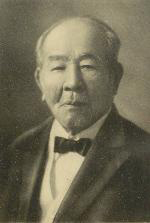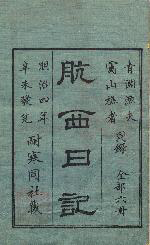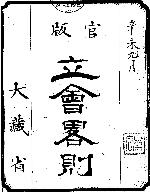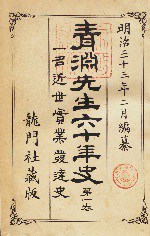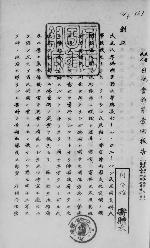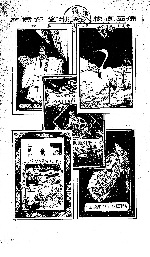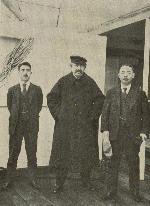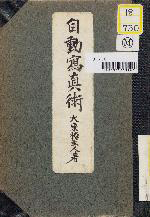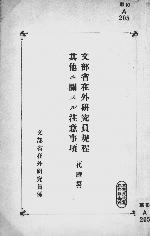![]()
Chapter 2: Industry
Section 3: Japan-French exchanges of business people
On New Year's of 1867, SHIBUSAWA Eiichi, who would later come to be known as the "father of Japanese capitalism", accompanied TOKUGAWA Akitake (1853-1910), who was acting for the Shogun TOKUGAWA Yoshinobu (1837-1913) in participating in the Paris International Exposition, and departed Yokohama on the French mail ship the Alphée. Akitake studied abroad in France for approximately a year and a half before returning to Japan due to the fall of the Shogunate government. SHIBUSAWA, who served as the accountant for Akitake's party, learned the mechanisms of capitalist economics from banker Paul Flury-Hérard (1836-1913), who arranged their stay. In particular, he stated in later years that watching Flury-Hérard's handling of the military made him acutely aware of the necessity of doing away with the social status system and the need for improved social status for businesspeople. After returning to Japan, SHIBUSAWA joined the Ministry of Finance and worked on establishing the joint stock company system and monetary systems and thereafter immersed himself in the business world in 1873 and starting up a number of companies.
SHIBUSAWA, INABATA Katsutaro and the other businesspeople who studied in France, also worked on the construction of the Franco-Japanese House and played important roles in French-Japanese exchanges.
SHIBUSAWA Eiichi
KŌDA Rohan, Shibusawa Eiichi den, Shibusawa Seien’ō kinenkai, 1939 [766-25] 
A biography of SHIBUSAWA by novelist, KODA Rohan (1867-1947). Planned for publication by the Shibusawa Seien Memorial Foundation on the 100th anniversary of SHIBUSAWA's birth, Rohan was hired to write the work through Iwanami Shoten for a manuscript fee of 30,000 yen. Rohan's brother, historian Shigemoto (1873-1954), was involved in the compilation of Shibusawa Eiichi Denki Shiryō [289.1-Si267Rs] and is also thought to have assisted with the writing of this work by providing materials.
SHIBUSAWA's adult life can be divided into 3 phases, the time until he resigned as an officer of the Ministry of Finance in 1873, the time from when he entered the business world until he retired from management in 1909, and his later years when he worked hard to contribute to social and public works, however this work mainly covers the 1st phase. It seems that Rohan felt that the real highlight of SHIBUSAWA's career was the hard work he did earlier in his life to establish the necessary systems in order for capitalism to take root in Japan.
In addition, Rohan's highly classical prose cannot be said to have been optimally suited to a biography, and it can be said that the clients were not necessarily completely satisfied with the results. After the war, OSARAGI Jiro (1897-1973) wrote Gekiryū Shibusawa Eiichi no Wakaki Hi, which was published serially in newspapers, on the recommendation of Rohan.
SHIBUSAWA Eiichi (Seien) and SUGIURA Kajin, Kōsai nikki, Taikandōsha, 1871 [特31-677] 
SHIBUSAWA was born to a farming family in Musashi no kuni (Saitama Prefecture), and learned Chinese studies from his cousin ODAKA Atsutada. During his youth he participated in the exclusionism movement and even planned to participate in an uprising, but the plan suffered setbacks and he travelled to Kyoto to avoid investigation and as a result entered the service of the Hitotsubashi clan. As a result of the family head, Yoshinobu becoming the Shogun, SHIBUSAWA became a vassal of the Shogun, and he was ordered to accompany TOKUGAWA Akitake to France.
This book is a record of their departure from Yokohama on New Year's 1867, to participation in the Paris International Exposition and their tour of Europe until their arrival in Paris in November of the same year, and was compiled and published based on memos and records of SHIBUSAWA and SUGIURA Yuzuru in 1871, when they belonged to the Ministry of Finance. The content includes vividly written observations from the exposition, admiration that the western food and coffee during the voyage was delicious (January 12), admiration of the showy dance parties (April 1) and general excitement at coming into contact with a new civilization, displaying an active curiosity and high level of adaptability. Gojunkoku Nichiroku is known as a journal of SHIBUSAWA's from the same period, and it is presumed that this text was compiled based on the other work. The Pari Gozaikan Nikki is an additional work from a later period detailing Akitake's life as an exchange student.
SHIBUSAWA Eiichi, Tachiai ryakusoku, Ōkurashō, 1871 [W373-65] 
SHIBUSAWA, who was formerly an exclusionist, recognized the need for constructing industry in Japan after coming into contact with Western civilization. After returning to Japan, SHIBUSAWA was appointed to the new government, and was a member of the Reform Office which was established in the Ministry of Civil Affairs and later in the Ministry of Finance. The Reform Office cooperated with OKUMA Shigenobu, ITO Hirobumi, INOUE Kaoru (1836-1915) and others to work on planning for various policies required for constructing a new nation, such as construction of telegraphs and railroads, establishment of a postal system, and the establishment of prefectures in place of feudal domains. Based on the model of France under the Second Empire with its rapidly progressing industrialization, SHIBUSAWA placed importance on circulating currency, products and information, and forming industrial capital by merging small capital, and promoted the establishment of banks and joint stock companies.
This text is a supplement to Kaishaben [106-283] translated by FUKUCHI Gen'ichiro (1841-1906), explains the establishment of commerce businesses, including banks, and was also published by the Ministry of Finance.
SHIBUSAWA resigned from the Ministry of Finance in 1873, and was appointed superintendent of the Dai-ichi Kokuritsu Ginko (lit. the First National Bank) which was established in accordance with the National Bank Ordinance of the previous year. Thereafter he worked tirelessly to promote development in business from the private sector.
Ryūmonsha (Ed.), Seien sensei rokujūnenshi, Ryūmonsha, 1900 [86-117] 
Having joined the business world, SHIBUSAWA was involved in the establishment and operation of a large number of businesses. These businesses spanned every field and some major examples include, Dai-ichi Kokuritsu Ginko (lit. the First National Bank) (present day Mizuho Bank), Shoshi Kaisha (lit. Paper Manufacturing Company) (present day Oji Paper), Osaka Boseki (present day TOYOBO), Tokio Marine Insurance Company (present day Tokio Marine & Nichido Fire Insurance Co.), Kyodo Unyu (present day Nippon Yusen), Sapporo Beer Company (present day Sapporo Beer), Tokyo Stock Exchange and the Imperial Hotel. SHIBUSAWA preached the union of Rongo to Soroban (lit. Analects and abacus), was not interested in the formation of conglomerates, and worked hard to foster the industry required for modernizing Japan.
Ryumonsha began as a study organization for students who idolized SHIBUSAWA (pen name Seien), and held debates and published the Ryūmon Zasshi [雑56-38]. This text is a biography compiled by Ryumonsha, mainly by his son-in-law SAKATANI Yoshiro (1863-1941) to commemorate SHIBUSAWA's 60th birthday in 1900. As implied by Alias Modern Japanese Industrial History, the path of SHIBUSAWA's career was synonymous with the progress of modern Japanese business world. The discourse part of his earlier work is known for another title, Amayogatari.
Nichifutsu kaikan (Ed.), Zaidan hōjin nichifutsu kaikan hōkoku, Nichifutsu kaikan, 1925 [14.5-363] 
After SHIBUSAWA retired from the business world, he mainly focused his energy on social and public works. The Kōsai Nikki records his observations on the Invalides in France and his deep impression with western welfare systems (April 20), and he was involved in social welfare projects, including participation in the operation of the Tokyo Prefectural Orphanage from 1874, early after his return to Japan. He also worked on international goodwill activities, such as carrying out peace-oriented diplomacy from the private sector when the anti-Japanese movement in America began.
The Franco-Japanese House, which in 2014 celebrated its 90th year since its founding, has become a central organization for handling academic and cultural exchanges between France and Japan, and at the time of its establishment SHIBUSAWA helped ambassador Paul Claudel (1868-1955), serving as its first Chairman of the Board of Directors. The Shibusawa-Claudel Prize, which was established in commemoration of the house's 60th anniversary, is awarded for superior research related to the culture of the other country. This text is the 1st report, published the year after the House's establishment, and shows SHIBUSAWA's name as one of the founding members.
INABATA Katsutaro
TSUCHIYA Tomisaburō, Jitsuyō futsukoku senhō, Inabata shōten, 1903 [81-814] 
INABATA Katsutaro was born to a sweet shop operating family in Kyoto, and was one of the Kyoto Prefecture exchange students who travelled to France with KONDO Tokutaro at the direction of Léon Dury in 1877. After going through a secondary school in Lyon, he studied dying at a technical school and worked at a dye house to learn the relevant skills. There was still discrimination against Asians, and he had an extremely difficult time as he carried out the heavy labor, even getting involved in physical fights with French workers at times. Thereafter, he studied practical chemistry at the University of Lyon and spent a total of 8 years studying abroad before returning to Japan. He participated in the establishment of the Kyoto Weaving Company, and provided instruction in dyeing techniques, however there was little benefit of mechanization of the dying process since labor costs were low in Japan at the time, and he was dismissed in 1890 as a result of the company's deteriorating earnings. Thereafter he deal in export of dyes and was successful in establishing a dye house in Osaka in 1897.
This text is a manual on French dying techniques published by Inabata Shoten (present day Inabata & Co., Ltd.). The beginning of the manual provides a list of products of the imported dyes that were available from the company.
INABATA Katsutarō, Ōa ni tsukaishite, Nihonhyōronsha, 1929 [578-238] 
INABATA succeeded in developing a khaki color dye for use in military clothing, which was used by the army during the Russo-Japanese War. Thereafter, in 1922 he was elected as the chairman of the Osaka Chamber of Commerce and Industry and appointed president of Japan Dyestuff Manufacturing (present day Sumitomo Chemical Co., Ltd.) in 1937, becoming a leading Kansai businessman. He was also active in promoting friendship with various countries from the private sector, acting outside of just his role in the business world as did SHIBUSAWA Eiichi.
This text is a travel journal of his journeys to Asia and Europe from 1926 to 1927 which he made in order to participate in the 10th International Labour Conference and as a representative of the Japanese business world on a return visit to French Indochina. He also revisited Lyon, where he stayed in younger days. INABATA worked tirelessly for French-Japanese exchanges and at the request of French ambassador to Japan Paul Claudel, in 1927 he cooperated in the establishment of the Franco-Japanese Institute of Kansai (Kyoto).
Daitōrō Shujin, Jidō shashinjutsu, NISHIDA Teiichi, 1897 [18-730] 
One of INABATA's more out of the ordinary achievements was that he is said to have been the first to introduce movies to Japan. He met Auguste Lumière (1862-1954), elder brother of the Lumière brothers who invented movies (cinematograph) in 1895, as a fellow student at a Lyon technical school. In 1896, INABATA travelled to France to observe spinning and weaving of muslin, and was shown the cinematograph, which was invented just the previous year, and proposed a contract as the dealer for the technology in Asia. The contact was concluded with the conditions that Lumière would dispatch cinematographer Constant Girel (1873-1952) for equipment operation, monitoring of box office take and to film Japan's scenery, and 60% of the sales would be paid as a premium. The first show in Japan took place in February 1897 the following year at Osaka's Nanchi Theater. It seems that INABATA was not personally interested in the profits from the shows, but anticipated allowing Japanese to visually learn about Western civilization using this new invention.
This text is considered the first literature written about movies in Japan, and was published as early as 2 months after the first show in Osaka. The latter portion provides a short story on the topic of movies.
SATSUMA Jirohachi
Monbushō zaigai kenkyūin kitei sonota ni kansuru chūi jikō, Monbushō senmongakumukyoku, 1933 [FD43-8] 
SATSUMA Jirohachi (1901-1976) relocated from Britain, where has was studying abroad, to France in 1923. His family ran Satsuma Shoten, Japan's top textiles store, and Jirohachi received a monthly allowance equivalent to 30,000,000 yen in today's currency, which he squandered in Paris social circles. He was known as "Baron Satsuma", and was also known as a patron of painter FUJITA Tsuguharu (1886-1968) and tenor FUJIWARA Yoshie (1898-1976). After the bankruptcy of Satsuma Shoten in 1935, he remained in France, and protected André Malraux (1901-1976) and other culturati under the German occupation. He sympathized with the idea of an International University Campus in Paris proposed by André Honnorat (1868-1950), and donated 200 million yen of his own money for the construction of the exchange student lodging Japan House.
This text is a notice aimed at overseas research personnel funded by the Ministry of Education, however it shows his name in the text "Japan House in the International University Campus in Paris" made possible by "Mr. Satsuma's donation". The house took in large numbers of exchange students over the years, and was an important point for introducing Japanese culture until the opening of the Japan Cultural Institute in Paris in 1997.

